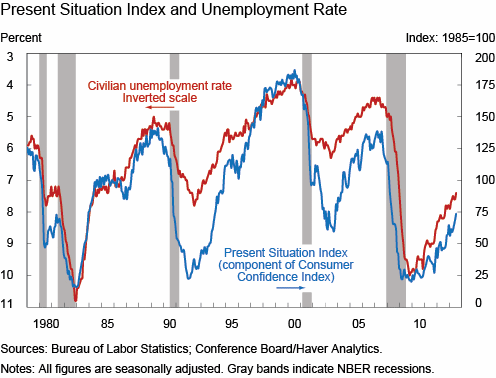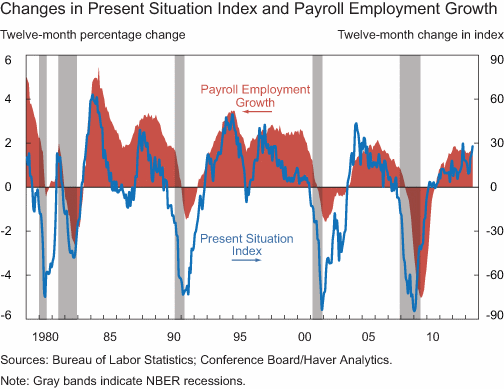Blog

Can Jobs Numbers Be Predicted by Consumer Confidence?
A recent entry in the NY Fed’s Liberty Street Economics blog makes a compelling case for the role of Consumer Confidence in forecasting labor market conditions. </p
Traditionally, confidence data is closely monitored because of the presumed insightrnit offers into future consumer spending and thus the health of the largerrneconomy. It is widely held that thernconsumer’s mood can independently affect the degree to which that consumer isrnprone to spend. Less well known is thatrnit can also signal incipient developments in the job market. This oversight leads analysts to look at itsrnpredictive ability for consumer spending while failing to study its correlation with employment measures. </p
In their blog entry the authors look at trends in arnparticular measure of consumer confidence, thernPresent Situation Index component of the Conference Board’s Consumer ConfidencernIndex-over the past thirty-five years and show its close association withrnmovements in the unemployment rate and in payroll employment. </p
The Conference Board measures consumer confidence based onrnthree questions that focus on expected changes in business conditions, jobrnavailability, and the respondent’s household income and two that focus onrnpresent business conditions and job availability. Responses to the first three make up thernExpectations Component Index the others form the basis of the Present SituationrnIndex; the Consumer Confidence Index is a composite of the two. The authors’ analysis suggests that thernPresent Situation Index is the more useful indicator of employment. <br /<br /In the following chart the Present Situation Index is plotted against thernunemployment rate. In this case the highrnlevels represent strong market conditions. rnIt is readily apparent that the two move very closely together includingrnthrough all five recessions since 1977. Lessrnapparent is the strong correlation (0.89) the Index has with employment twornmonths in the future. </p
 </p
</p
The Present Situation Index is also laid against payroll jobrngrowth which is based on different data than the unemployment rate but isrntypically growing as unemployment declines and vice versa. Again, the close movement of the two isrneasily seen and again, close examination shows the Index foreshadowing movementrnin payrolls by a couple of months. In particular, twelve-month changes in thernindex are most highly correlated with twelve-month job growth four months intornthe future-the correlation is 0.83.</p
 <br /<br /<br /Because of the release schedule and the revision pattern of the two indicatorsrn(consumer confidence numbers are released over a week before payroll employmentrndata and revised only once while employment data undergo annual benchmarkrnrevisions) the authors suggest another way in which the comparisons could bernuseful; the possibility that the confidence measure could predict revisions tornpayroll employment which can occur up to a year-and-a-half after the firstrnestimate. <br /<br /Can consumer confidence levels also predict turning points? On the chart the major turns in the PresentrnSituation Index tend to precede turns in the unemployment rate, particularlyrngoing into recessions and also tend to foreshadow cyclical peaks in thernunemployment rate which often occur well after the end of a recession. It also appears able to signal sustainedrndownturns in payroll employment. </p
<br /<br /<br /Because of the release schedule and the revision pattern of the two indicatorsrn(consumer confidence numbers are released over a week before payroll employmentrndata and revised only once while employment data undergo annual benchmarkrnrevisions) the authors suggest another way in which the comparisons could bernuseful; the possibility that the confidence measure could predict revisions tornpayroll employment which can occur up to a year-and-a-half after the firstrnestimate. <br /<br /Can consumer confidence levels also predict turning points? On the chart the major turns in the PresentrnSituation Index tend to precede turns in the unemployment rate, particularlyrngoing into recessions and also tend to foreshadow cyclical peaks in thernunemployment rate which often occur well after the end of a recession. It also appears able to signal sustainedrndownturns in payroll employment. </p
Wheneverrnit has turned negative by more than 15 points the economy has entered into arnrecession, the exception being its late “prediction” of the 1982 downturn whichrnis often considered the second part of a double dip in the 1980 recession. It has also performed well in signaling anrnincipient cyclical upturn in employment. rnWhile it was out of sync with the last few recessions it was likelyrnbecause the early stages of those recoveries were “jobless.” If one focuses on improvement in employmentrnrather the end of the recession then the index has always performed well. <br /<br /The authors looked at the occasionsrnwhen the Index deviated from its usual relationship with the job market andrnfound there were discrepancies in degree. rnFor example, the index fell almost as low in its relationship with thernmild 1990 recession as it did with the 2008 Great Recession. This shortcoming arises from the index beingrnbased on diffusion indexes that measure whether a given respondent thinksrnthings are bad, not on how bad they are. rnThus once the level reaches an exceptionally low level it can't go muchrnlower. The index indicated a possiblernrenewal of the 2001 recession in 2003 upon the invasion of Iraq but it didn'trnhappen. Other instances wherernsignificant events looked as though they might trigger a recession such as thern1987 stock market crash, the Index held up well and proved the forecastersrnwrong.</p
So why should the general public be able to predict the jobrnmarket earlier than employment data? Thernauthors say one likely reason is that many survey respondents are in the laborrnforce, and almost everyone has close friends and relatives that work. Thus they are attuned to the general tone of thernjob market-at least in their region or neighborhood. They may be well aware ofrnlocal business problems before layoffs begin and equally likely to know of jobrnopenings before they are filled and become part of a statistical report.
All Content Copyright © 2003 – 2009 Brown House Media, Inc. All Rights Reserved.nReproduction in any form without permission of MortgageNewsDaily.com is prohibited.
Latest Articles
By John Gittelsohn August 24, 2020, 4:00 AM PDT Some of the largest real estate investors are walking away from Read More...
Late-Stage Delinquencies are SurgingAug 21 2020, 11:59AM Like the report from Black Knight earlier today, the second quarter National Delinquency Survey from the Read More...
Published by the Federal Reserve Bank of San FranciscoIt was recently published by the Federal Reserve Bank of San Francisco, which is about as official as you can Read More...

Comments
Leave a Comment